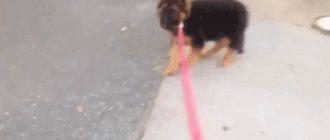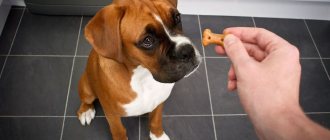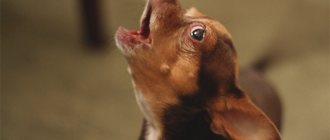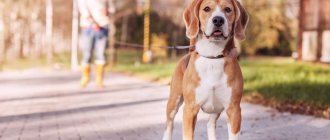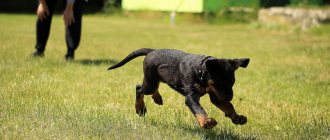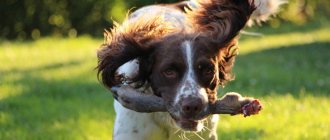Common Mistakes
Walking puppies that are too young and have not undergone the first vaccination can lead to infection and even death if they come into contact with other dogs. Such babies can only be walked in your arms.
Attempts to calm a puppy showing signs of panic (plaintive whining, tucking its tail, trying to retreat into the bushes, trembling all over the body). Soothing stroking and coaxing will be perceived by the puppy as praise for this behavior. To prevent a repetition of the situation, you need to fraudulently lead your pet to the object that frightened it and convince it of its safety. If the puppy obeys and behaves calmly, you should praise him and give him a treat.
Read also: Why does VK crash on my phone?
The most correct tactic for accustoming a puppy to the street should be the tactic of a reasonable compromise. You can’t constantly take him out into the street, full of strong irritants, but it’s equally wrong to protect him too much from city noise.
Excessive haste , attempts to forcibly drag the puppy onto the street that frightens him. This behavior of the owner can only provoke aggression in the pet for the purpose of self-defense.
Incorrectly built hierarchy in the relationship between owner and pet. A puppy whose every whim is immediately fulfilled may decide that he is allowed to manipulate his owner.
How to deal with it
Overcoming a puppy’s fear of walking outside is not an easy task, requiring great perseverance, patience and strength of character from the owner. The key to success at the initial stage of adaptation is the establishment of a trusting relationship between the owner and the puppy.
Having recognized him as an unconditional leader, the puppy will trust him and know that the owner can protect him at any moment. Achieving this goal may take a long time, but without this it is unlikely that any success will be achieved.
For a puppy who is afraid of walking outside, you can purchase a tray for the first time to discharge its natural needs. Gradually moving the tray towards the front door, teach the puppy to move in this direction. Soon the moment will come when the tray will be outside the front door and the puppy will begin to ask to come out. This technique is not very convenient for city houses, since not all neighbors may be loyal to this practice.
The best place for walks would be a quiet park, but gradually, with the help of your favorite treats, you need to slowly bring the puppy to sources of noise, accustoming him to both transport and the inhabitants of city streets.
Sometimes purchasing a comfortable leather collar and a long leash helps to cope with a negative attitude towards walking. Some pets do not like to go for walks because of inconvenient walking accessories: a tight or spiked collar, a leash that is too short, or an incorrectly selected harness.
A small puppy is gradually accustomed to bright sunlight and loud sounds of the surrounding world by carrying him outside in his arms. If your pet's size does not allow this, you can take him to an open window or walk him on the balcony. If your pet is terribly afraid of other dogs and street noise, you need to use a calm, quiet place to walk it: a corner of the park, a deserted wasteland. You can’t force things, let everything happen gradually.
Some owners, wanting to overcome their puppy’s fear of the street, act unconventionally by walking a hungry pet. They use their favorite treat to lure him over the threshold. This method is far from perfect and is not always effective, since you still only need to walk a well-fed dog, and some puppies prefer to remain hungry rather than go for a walk.
If your puppy wants to play with a strange dog, you must first talk to its owner to make sure the stranger is loyal to your pet.
You can try to lure a pet who is afraid to cross the threshold of the apartment with his favorite treat or an interesting game.
When going for a walk, you need to take your puppy’s favorite toys with you and keep him busy with interesting games: this will distract him from his fears and shorten the time it takes to adapt to the street.
If the puppy is afraid of bright daylight, try taking him for a walk in the dark: having gotten used to walking in the dark, after a while he will ask for a daytime walk.
Some puppies do not like to go for walks, not because they are afraid of the street, but because they are very cold. The thermoregulation of their body is not designed to instantly adapt to sharply changing environmental temperatures, so it is recommended to dress dogs of short-haired breeds before going outside.
It's boring to walk
Active dogs that love to run and explore may stop loving walking if they walk the same route every day exclusively on paths. Even if they don’t refuse to leave the house, getting ready for a walk is perceived without much enthusiasm and willingly turns back.
In this case, it is imperative to diversify street activity. Dogs that do not fully satisfy their hunting instincts can become depressed, get sick, and change their behavior beyond recognition (become uncontrollable and irritable). Try to take a new route each time. Play outdoor games with your pet even in winter.
Disease
Domestic dogs are completely dependent on the daily routine and pace of life of the owner. Thanks to the ability to adapt, within a short period of time, the dog’s body begins to work at a “comfortable” pace for it. It is thanks to this feature that adult pets tolerate going to the toilet and do not feel acute hunger between feedings.
Most owners whose dogs suddenly refuse to go for walks immediately suspect illness. There is some truth in these suspicions, especially if the dog has suddenly become apathetic.
The first thing to do if the dog refuses to go for a walk is:
- Superficial inspection - we check the condition of the fur, skin, paws, claws, eyes, ears, mouth.
- We examine the mucous membranes.
- We check the temperature of the mucous membranes and body.
- We monitor your appetite and drinking regime.
- We palpate the joints and abdominal area of the dog.
Arthritis and other musculoskeletal diseases
Joint inflammation is a common ailment in dogs, especially in older dogs. The following symptoms are observed with arthritis:
- The dog tries to move less.
- Weight gain occurs due to decreased activity.
- The pet is reluctant to walk on stairs.
- There is lameness, whining and other signs of discomfort when the dog gets up after sleeping.
Dysplasia of the elbow and hip joints. The problem is that most dogs are prone to dysplasia from birth. Symptoms:
- It is difficult for the dog to get up after sleep.
- Until the pet moves away, he has a wobbly gait. With hip dysplasia, a rabbit gait may be observed.
- If left untreated, the condition slowly but steadily worsens.
- At the slightest weight gain, the dog begins to avoid any activity.
- It is difficult for a pet to jump, maneuver while running, or walk up stairs.
The main problem with dysplasia is that it cannot be treated.
Physiological
Bad weather
Rain or snow itself rarely causes a dog to be reluctant to go outside, but wet, dirty paws and a freezing belly are another matter. Contrary to popular belief that dogs don’t get cold and they don’t need clothes and shoes at all, a dog’s ability to withstand low temperatures and humidity directly depends on the breed.
Agree that the coat of a husky and a toy terrier, for example, differ in their ability to retain heat. The smaller the dog and the shorter its paws, the faster it will freeze. Owners of small, smooth-haired or short dogs should not neglect clothing and shoes for their pets (by the way, shoes will protect their paws from snow reagents).
Inconvenient muzzle, collar, leash
Usually this is immediately noticeable: the dog was just calm, but when he saw the muzzle, he immediately hid, or even grumbled. Disobedience must be strictly suppressed, but you can also think about buying more convenient ammunition.
Health problems
- Age-related changes include fatigue, decreased visual acuity and hearing, etc. - all this leads to the fact that the dog is no longer able to experience the previous pleasure from a walk, and therefore the desire to walk gradually fades away.
- Joint pain that worsens when walking up stairs, recent or poorly healed injuries , etc. conditions can be identified by the way the dog moves and a veterinarian can be consulted for treatment.
Psychological
Fear
Dogs can be afraid of walking for various reasons, for example:
- low socialization of the dog caused by too early separation from its mother or life in a shelter: a puppy, and sometimes an adult dog, is afraid of the outside world and hides behind its owner at the first opportunity;
- stress during one of the previous walks: the dog was scared and does not want to repeat the negative experience (a car honked loudly, there was a clap of thunder, fireworks flashed brightly, there was a conflict with another dog - there may be plenty of reasons);
- change of place of residence - even moving out of town can be the reason for the dog’s reluctance to leave the house and go out to where everything is so unfamiliar, and there is nothing to say about changing the place of walks from a quiet park in a residential area to a busy boulevard in the city center.
There is no need to scold or feel sorry for a frightened dog, especially if we are talking about a puppy. A calm, friendly attitude and encouragement at every part of the path traveled in the form of praise or treats will help the pet regain self-confidence and calmly leave the house. If your attempts are unsuccessful, seek advice from a competent animal psychologist.
Inconvenient equipment
It happens that the muzzle presses, the collar rubs, the clothes press, and therefore the pet does not want to go for a walk, since for him every step promises discomfort or pain. Most often, hostility to equipment is accompanied by growling and refusal to put on ammunition.
Calluses and sore spots on your pet’s body will help you figure out what exactly you don’t like. If there is nothing, try loosening the collar, discard the muzzle, unfasten the raincoat and watch your pet’s reaction. In the future, purchase more comfortable equipment.
Tips for walking your puppy
If you still can't get your puppy to move on a leash, try these techniques:
- Take the puppy 20 or 30 meters from the house and let him return on his own. Your puppy will experience the same feeling as leaving the house, but knowing that he is returning to a safe place will encourage him to keep going.
- Drive the car with the puppy a block or two away from the house and walk the puppy back into the house.
- Travel to a new place. A different neighborhood, a quiet park, or a dog-friendly pet store are all ideal places for your pup to socialize. Plus, not having a home in sight can help your puppy explore rather than retreat.
- As a reward, choose an expensive treat or toy that your puppy will only receive during a walk. Your pup will want to go for a walk to earn that special treat.
- Enroll in a positive dog training class. This is a great way to socialize with your puppy, and you will also receive practical help tailored to your puppy's specific needs.
Whatever techniques you use, stay positive while walking. Your puppy will sense your emotions, so if you become worried or upset, it will affect your puppy's perception of the experience.
Seasonal allergies
Almost all owners are well aware of the dangers of food allergies, but the dog's body can react sharply to dust, pollen and other bloom products. If your dog is allergic, during the flowering season of the grass he may feel ill when walking. You may not notice this visually, but allergy symptoms will make themselves felt:
- Swelling of the mucous membranes.
- Non-localized itching.
- Decreased appetite.
- Copious discharge from the eyes and nose.
- Cough, shortness of breath and other breathing problems.
- Skin irritation, even urticaria.
- Rarely and only in severe forms of allergies - nausea, vomiting, diarrhea.
Recognizing your dog's fear
Your dog's fear may manifest itself in obvious ways, such as outright refusal to walk or pulling hard on the leash to try to get back into the house. However, a dog in distress may signal its fear in more subtle ways, such as crouching low to the ground, keeping its tail tucked, panting unrelated to temperature or activity level, frequent yawning, or trembling.
Forcing dogs that exhibit these stress signals to “face their fears” will only make the problem worse, so punishment and intimidation have no place in the rehabilitation process.
© shutterstock
Owner actions
When faced with the problem of refusing to walk, the main task of the dog owner is to find out the reasons. Once the owner determines the possible cause of the refusal, action can be taken to correct the behavior.
A dog that refuses to go for a walk due to fear must be reassured. Affectionate words and encouraging movements are very important for a pet. You can take a treat with you and try to lure the dog outside. Young dogs who are afraid of going on walks can be lured into play.
If the animal protests, you can try a trick. For example, place a bowl of food near the front door, giving the animal time to get used to it. Further, during the feeding process, so that the dog does not get scared, you can leave the front door ajar. This will allow you to build an associative series.
The owner's actions should be smooth but decisive. You must not scold the animal and under no circumstances use physical force.
Do you want to know more about the article or something? Call +79774692712, we will advise you.
Source
Reason No. 4: fatigue and lack of mood
No matter how it sounds, dogs get tired too and they may also not be in the mood for long and enjoyable walks. This may also be due to general fatigue, for example after a visit to the veterinarian or from long games or lack of strength.
To keep your dog in good shape and help it replenish its strength and energy, it is important to feed your pet properly.
For example, Dog Chow® food is great for active dogs. A complete diet made from natural ingredients will give your pet energy and restore strength. The composition includes a natural prebiotic that helps improve digestion. The brand's diets do not contain artificial colors, flavors or preservatives. You can find out more about the food by following the link.


